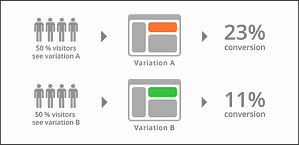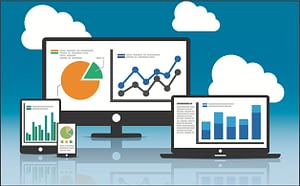“Online advertising is the answer for rapid, scalable revenue generation…”
Or not.
Try this quick quiz. Online advertising is either:
(A) The quickest, surest way to generate sales for your online business, or
(B) The quickest, surest way to waste time & money and get nothing in return.
If you chose “A”, the “quickest, surest way to generate sales”, you are certainly in the majority opinion.
Unfortunately, the reality for many online businesses is “B”, as their initial efforts often produce a negative ROI.
This isn’t to say that you shouldn’t advertise your business, or that you can’t get more than a dollar back for each dollar spent.
Nor should you infer that online advertising doesn’t work.
Case-in-point: we recently rocketed a new Shopify store selling POD (“Print-on-Demand”) products to 5-figures in just over 90 days using only Facebook ads!
Done properly, online advertising is absolutely the ‘quickest, surest way to generate sales’ – or leads, webinar registrations, etc. – for any business.
Like printing money. If only…
When Online Ads Printed Money
When Google launched Adwords back in 2000, it was a virtual cash machine, seemingly able to generate sales on demand.

Back then, the entirety of online advertising consisted of just ‘banner ads’ – what we now refer to as ‘display advertising’ or ‘display ads’.
The PPC or “Pay-Per-Click” model was entirely new: any business could target any individual question, phrase, or keyword search with an inexpensive ad specifically tailored to it, paying only if someone actually responded.
With a simple-to-learn self-serve platform, it drew enormous numbers of businesses, and many of those early adopters saw unheard-of returns.
But those ‘glory days’ are long gone; competition, costs, and complexity have all gone way up, while overall returns have slowly eroded.
And yet many business owners still see this type of online advertising as a panacea for increasing sales.
To further muddy the waters, there seems to be a rising drumbeat from “experts” extolling the virtues of social media marketing, and bemoaning the folly of businesses that don’t jump all over Facebook advertising.
(It’s even reached the point where “social media marketing” has come to mean “Facebook advertising”, which has become synonymous with online advertising.)
Great Idea, Not-So-Great Results
It’s no wonder that business owners, and especially new online ventures, assume that running ads will ‘turn on the tap’ for new visitors and sales.

In a typical scenario, either the business owner, the person in charge of their website, or an agency will do some basic keyword research, craft the most compelling ad they can, and run with it.
Of the people who then see the ad, some percentage will click on it; and from those clicks, some fraction will result in a sale.
How well the ad campaign performs overall (the ROAS or “Return On Ad Spend”) – what those actual percentages turn out to be – depends on a lot of variables.
Beyond budget and search volume (Google) or audience (Facebook), which determine how often an ad runs, there are a host of factors that dictate how many clicks the ads get, and how well those clicks convert into sales:
- Ad headline
- Ad copy
- Landing page
- CTA (“Call to Action”)
- Time-of-day & day-of-week the ad runs
- Searcher or audience demographics
- Geography
(Those are just the ‘big’ ones; even the color of a “Buy” button on your landing page can have an impact on net conversions.)
In most cases, as intimated above, the advertiser does an initial, lightly-researched ‘best guess’ for each of these components.
Predictably, the results are neither optimized nor ideal.
Compounding the problem, most advertisers experience declining performance over the course of each advertising campaign.
Help Is At Hand
Fortunately, there is a solution to this common dilemma, which has the extraordinary additional benefit of providing ever-increasing performance and returns.

Split-testing (sometimes referred to as “A/B testing” or “multi-variate testing”) is a simple yet brilliantly effective method for achieving better results from any online advertising effort. It’s based on the deceptively-simple premise that everything can be improved.
The process of split-testing is straightforward: you take your original ad or landing page, change something, and split your traffic between the original and the changed version.
Invariably, one will outperform the other.
You then scrap the lower-performing version and repeat the process.
Since no ad campaign is perfect coming out of the gate, this can – and should – be done for every factor that impacts ad performance.
Even If You Don’t Know What You’re Doing
To paraphrase Mark Twain, “It’s not the things you don’t know that will hurt you, it’s the things you know for sure that just aren’t so.”
Because it’s an evolutionary process, you don’t necessarily have to know which elements to change, or what to change them to, for it to work.
Not “knowing what you’re doing” can even help overcome the natural tendency to think we know what’s best in areas we’re familiar with.
Consider this hypothetical scenario:
Joe of “Joe’s Shoe Emporium” hires his wiz-kid nephew to advertise their shoes and increase online sales. The kid knows the technology cold, and sets up an ad campaign using all of the latest best practices.
The ads run, and the results are just ok.
In an effort to improve his results, the kid begins split-testing.
Predictably, performance and ROI steadily improve, but the biggest improvements come with changes to the ad’s headline, something Joe would have been adamantly against changing.
Had the kid consulted Joe, he would have been told to leave the headline alone; Joe’s been selling shoes since forever and feels certain he knows what his customers respond to.
Because he didn’t consult Joe – and as a direct result of “not knowing what he was doing” – the kid simply split-tested every element he could.
Said another way, it almost doesn’t matter what you do – as long as you continue the process, results will continue to improve incrementally.
Online Advertising – And A Whole Lot More!
Split testing is one of the invaluable ‘universals’ in online marketing: it can be applied to virtually any- and every aspect & stage of the process: online advertising, CRO (“conversion rate optimization”), even email marketing.

If fact it would not be irresponsible to say that you should be actively split-testing every component of every stage of your marketing path.
Online advertising: test each component of your ads as listed above.
CRO: test each component of your landing pages (titles, pictures, layouts, ‘Call-to-Action’ buttons, etc) and payment process (checkout page and it’s components).
Email marketing: test headlines, sending days/times, follow-up sequences, etc.
Marketing tactics: test sales, sale types, ‘exit pop-ups’, and each of their components such as type, who & when to apply them to, etc.
By its very nature, split testing will improve anything you apply it to. Which begs the question: why NOT apply it to everything you can?
With all that, however, it’s important to point out one critical consideration: effective split-testing requires traffic.
A lot of it.
And depending on the types of tests, even a lot-lot (“lot-lot” is a technical term for, well, lots)!
In order to get meaningful results, you have to have a large-enough sample size. What that size is depends on many factors but suffice it to say, you can’t produce meaningful results with a trickle of traffic. And the more traffic you run through your tests, the more accurate and certain your results will be.
Ever-Improving Results: Simpler Than It Seems
As simple as the concept is, it’s not hard to imagine that implementing it is anything but.
Happily, there are plenty of tools available to help even the most tech-averse employ this strategy of ever-improving results in sales, lead generation, CRO, and just about anything else.

Both Facebook and Google have built-in split-testing capability in their respective advertising platforms.
Google also has a separate landing page split-test facility called Content Optimize.
All of Google’s testing tools are free to use.
If you don’t want to rely on Google, there are some very capable, easy-to-use tools available, most of which offer a free trial period.
You can find an excellent list of top tools here: https://www.crazyegg.com/blog/best-testing-software/
If you want some inspiration or help in choosing what to test first, check out Neil Patel’s article “50 Split Testing Ideas (You Can Run Today!)”
MarketingExperiments has a wealth of worthwhile info, but most impressively, a collection of thousands of “marketing experiments” where they show you two versions of something being tested. The winner is then revealed – along with some insightful analysis to help you understand why it won.
Conclusion
“Field of Dreams” is a terrific movie, but the notion that “if you build it, they will come” doesn’t carry over well to business, and is a particularly bad guiding principle for online advertising.
Just because you start advertising online doesn’t mean your sales will increase, or that an increase in sales will translate into a net positive ROI.
On the other hand, even poorly-performing advertising strategies and efforts can be turned around through split-testing.
But why limit the benefits of split-testing to advertising?
The same ever-improving process can be applied, with great effect, to nearly every aspect of sales & marketing.
Email marketing, lead generation, social media marketing; even individual components like product pages or sign-up forms can all reap the benefits of ongoing incremental improvement.
Before you pull the plug on marginal ads or accept mediocre results as “just how it is”, consider this:
The early days of online advertising are indeed past. But the stellar returns that Adwords early adopters saw are still achievable once you put that ‘ever-improving’ process in place!




